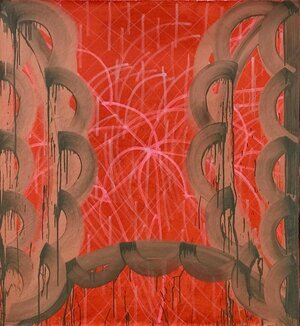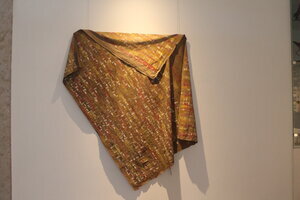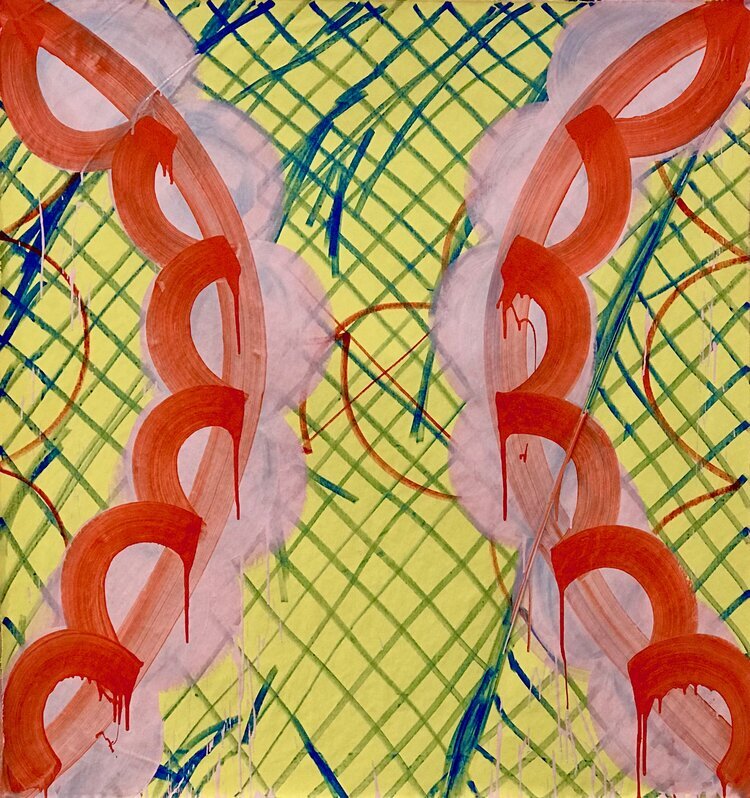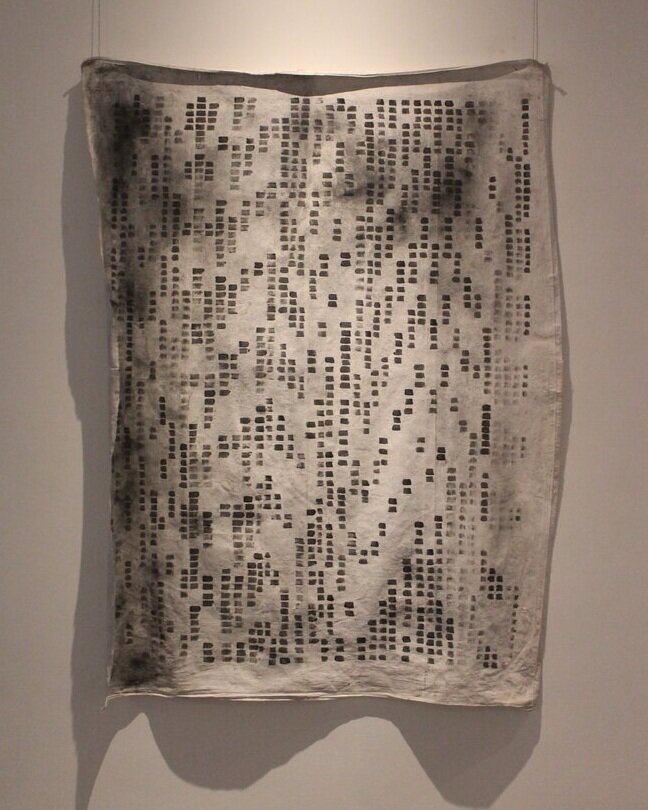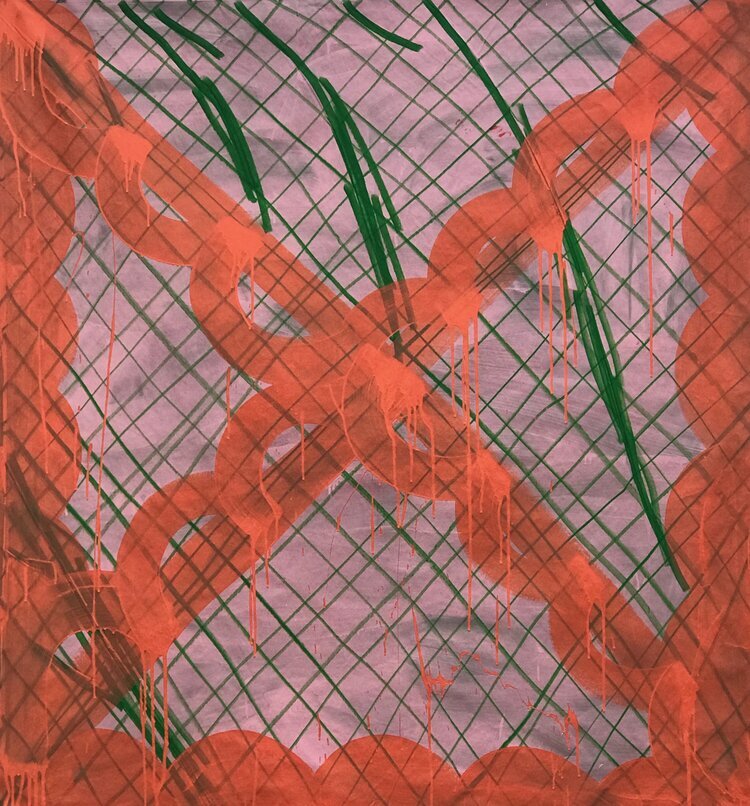LONG RANGE STUDIO VISITS
Anne-Marie Cosgrove and Henrique Neves
In this conversation as part of our Long Range Studio Visits we introduce Henrique Neves and Anne-Marie Cosgrove. Artists talk about their practice during confinement and techniques they use while painting. They also discuss importance of questioning and rethinking older works and discovering new methods of painting.
Anna-Marie Cosgrove, SPECTACLE, acrylic on canvas, 170 x 152 cm, 2019
Anne-Marie Cosgrove often compares her drawing and painting with the brush with graffiti and other forms of street art. She enjoys the spontaneity of writing with the brush and sees her work as an attempt to contribute to that perceptually formal and historically refined space of painting. With her newest work, she has taken a direction away from using text and cursive writing to using a repetitive and singular cursive line. She focuses on refining the brushstroke and simultaneously slowing down the speed with which she approaches her painting activity.
Henrique Neves, Laid in Earth, painting; cotton, acrylic paint, glue; 1300mm x 1800mm, 2019
Henrique Neves’ creative practice happens by combining and intertwining forms, materials, interests and concepts. The work can begin with an image, a narrative, an artifact, a concept, or a given fact, and references the context in which that thing originates Neves likes to depart from something – an idea, or an object – transforming or dislocating it. By doing so he tries to create dialogues and frictions between varied practices; drawing, flower arrangements, architecture, decoration, contemporary art, sewing, as well as others.
Anne-Marie Cosgrove, ALL NETS HAVE HOLES, acrylic on canvas, 170 x 152 cm, 2019
HN: Hi Anne-Marie, so nice to virtually meet you. To get us started can you present your work in a few lines?
AMC: Hi Henrique, nice to meet you also. I approach my work intuitively, I use paint because of its physical properties to cover, to be transparent and to show movement in the gestures of painting. My interest lies in the mechanical processes of painting as an activity and the interactions of the individual surfaces (layers) with each other over time. I am also interested in the activity of repetition and the way that hand applied repetition breaks down to reveal the human actions on the surface. I like to use systems of sorts, to invent ways of using line to cover and reveal what has gone before. I also work in multiple series at once. If I find something of interest visually, I usually explore it in several works over a period of time, looking for the most variations in/of the process.
For the past few years, I’ve been exploring a familiar 2 dimensional visual problem, that of the edges of the surface. Boundaries. Rather than treating the edges as problematic or as if they were not there, I try to focus on the sense of framing, of picturing, of presentation. What about you?
HN: I am currently making paintings, more precisely mark making, on second hand textiles. The marks are often related to rhythmic notations, meaning that while I paint I try to follow a rhythm in my head. I either create that rhythm and gesture or I follow a rhythm I’m familiar with. They are always simple gestures and marks, but raga, minimalist music and soundscapes are often inspirations, both in their structures and because of how they have been talked or written about. Relating to a musical system allows me to engage more physically as I concentrate more on the act of making than on looking.
The pieces are the result of physical gestures of repetition, of sedimentation, of erasure and addition. They are physical both in the making how I stress the particular materials used (paint, glue, dry pigments, old textiles), the construction of a painting (I use staples, or intervene by sewing) and through the mode of display (creating creases and folds). At the start of the lockdown I persisted in developing some of the work I had been doing, almost like a laborer of my own pieces. That felt like a gesture of defiance in times of uncertainty. Could you say something about how the coronavirus crisis affected your work?
Henrique Neves, Unknown, painting; cotton, charcoal, acrylic, glue, 1300 mm x 1800 mm, 2019
AMC: My ability to focus was the first to be disrupted. Like everyone, I haven’t been able to see my family, my sons, my parents etc. since the crisis started. However, I’m used to working in isolation so that part is unchanged. I’m able to work from home and I was also able to order my supplies and have them shipped. I began working on paper and for the past month have worked on setting aside negative thoughts. Of course it becomes easier as time goes on and there is more hope for survival for as many as possible. On a human scale, I’m devastated. As an artist/producer, I can’t stop wanting to address the issues of fear, isolation and distance from loved ones, friends etc. I’m not sure how my work is addressing the issues at the moment. I am very close to it at this point in my production. But my work has also grounded me through this crisis, I need it more than ever. My habit of working daily hasn't changed. I get up and go to the studio which is now where I live. I look at the work I produced the day before and the in-progress work.
I’ve taken out five portfolios of works on paper that I began in 2018. I have over 100 drawings that I’m now spending time with, reviewing and organizing thoughts about the different processes. I’m trying to take in an overview, arranging the works in different orders of production so that I can compare them with the new works. It is a process of trying on new ideas to see whether they hold enough weight to have an impact on me in this current situation. As I produce new work I question what it means to be working as an artist in these times? What do you think?
HN: I do not have an answer to that yet. However, as I mentioned, I am starting to think about what I find important in my work. Ideas of care and an awareness of environmental concerns are important to me. Biophilia is a concept I admire (as I admire Bjork, whose work introduced me to it). Most of the time those concerns are present in the materials I use and in the care I put into the work and how I make it. I’m also interested in what I think of as the opposite of that, which is violence - something that has often also been present in my work. I know that I have no direct statement to make, but I do think that in the concern for the environment that surrounds me, in my anger towards its abuse, in my reaction to the abuse of nature, people, artifacts, might reside some of the answers.
Anne-Marie Cosgrove, GENERAL DRIFT, acrylic on canvas, 170 x 152 cm, 2019
AMC: And how has it affected your day to day life and studio practice?
HN: My life has changed and is changing because of the crisis: financially I am much more unstable, work opportunities have been postponed or cancelled. Some plans, and dreams, are on standby. I recently got gallery representation, right before all of the international art fairs were cancelled! On another level, it’s generated a sense of loss, (though that is not related to mourning: I have no friends or family directly affected by the Virus) because my practice has been quite disturbed: I generally work towards showing work and sharing it. I had exhibitions planned for the next 6 months, all of which have been canceled or postponed. So I started asking myself what was the point of working, when not only my world was stopping, but the world as I knew it was going through big changes.
There have been different phases in this. Initially, I continued to labour in the studio. That phase is now over; I am again questioning the work and searching within it. However, the questions that arose in the beginning of the pandemic - when I started seeing all my plans fall apart, when reading the news was addictive and sickening - remain very present. How do I make the quest for silence and peace that drives a lot of the work, not just a personal quest, but a wider search? How might we react to this acute sense of fragility and temporality in these times?
AMC: I can say strongly that I share your thoughts and doubts about future work however I find they ebb and flow. Some days are much more positively acted upon than others. Looking at the images, you have a strong direction in your work that will be a positive source for your future work. I always feel that my work is descendant from previous works and can be both future and past combined.
I am taking long walks with my partner and, although he’s not specifically an artist, he’s had to put up with my ramblings about this and that for the past two months. I always tell him that he doesn’t have to answer, just let me talk! He’s a wonderful, patient man to be able to spend so much time with. I hope you have a similar relationship upon which you can rely. I feel that proximity or distancing is something that artists have had to deal with for a long time. Isolation for many is not new and maybe even necessary. I have to believe that the work I produce over these times will be relevant after this is over. Only time will tell but it is a necessary endeavour nonetheless.
The distance between Toronto and Lisbon is something I think about. I had plans to return this year and often think about the people and places I would like to see again. PADA Studios was an incredible experience for me in many ways. I think that despite the loss of physical contact with other artists here and abroad, just being able to speak with you, studio to studio, has been uplifting for me.
Henrique Neves, Dark Matters, painting, cotton, acrylic, glue, thread, 1300 mm x 2000 mm, 2020
HN: As the experience of lockdown seems to be easing up I would love to write that it lead me to more introspection, insight and new ideas, but unfortunately, I feel that it has only exacerbated feelings of uncertainty and fear to a practice that in itself is fragile, laborious, insecure. Nonetheless, the great challenge will be to incorporate those feelings in a productive and generous way.
A few days ago Michael, my husband, and I were listening to a reading by Garth Greenwell. He mentioned how in his books he uses so many of the insults and words that hurt him terribly while growing up. He mentioned the possibility to turn what was once scary into something other, something that in that reuse is recreated and that empowers and liberates the user. He said that the exact words used by his father to insult him and throw him out, were used in one of texts in a sexual/ love situation. They became a mode to create pleasure and fulfillment, liberating the character (and I guess himself.). This process of using negative feelings and experiences can be messy, confusing, violent. But in order to give meaning to the last few weeks, I will have to digest and incorporate the changes. I will have to live with new ghosts and hauntings and add them to my world. Only so, these imperfect and damaged times might become relevant and meaningful. How that might embody, I still have no idea. My work kept me safe. I also became aware of how much I need to share and discuss work with others and how painfully alone I have been feeling. Normally, I try to actively change that sense of isolation by meeting people, showing work, talking about it or believing that I will do it soon. But none of that has been possible lately. Thinking more productively, and dynamically, this whole phase is making me question my politics and aesthetics. I have not found answers, but the questions are here. Right now I am very much looking forward to work. I have no idea where this sense of hope comes from, but I can say that a lot of the fear that was binding me and that I felt I had to react to, seems to be dissolving. You mention revisiting old drawings and I also feel like I might have to revisit some of my old pieces and revisit the sense of excitement and discovery I felt in them. I have been thinking a lot about ‘An Artist On The Floating World’ by Kasuo Ishiguro, and Biophiliaby by Edward O. Wilson.
AMC: I will have to look it up, thank you Henrique for sharing these thoughts with me.
HN: And thank you Anne-Marie.
For more information and to see more examples of work visit
